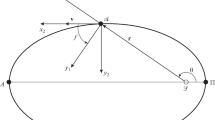Abstract
The observed fact that light changes of the asteroids exhibit no beat periods is interpreted as an indication that they do not wobble in space like spinning tops, but spin about only one axis (possibly — but not necessarily — inclined but little to the plane of their orbits). Since, moreover, the damping of three-dimensional rotation by jovi-solar attraction would require a time which is long in comparison with the age of the solar system, it is concluded that the present uni-axial rotation must represent a property preserved from the time when the asteroids were formed. This would seem to testify against their origin by collisional fragmentation of larger bodies; for in such a case the resulting solid splinters would still today be characterized by a random distribution of their angular momenta in three dimensions.
Similar content being viewed by others
References
Alfvén, H.: 1969,Astrophys. Space Sci. 4, 84–102.
Tisserand, F.: 1891,Mécanique Céleste, Gauthier-Villars, Paris; vol. II, Chapter 23.
Author information
Authors and Affiliations
Additional information
The writer owes this assurance to Dr. Thomas Gehrels (private information).
Rights and permissions
About this article
Cite this article
Kopal, Z. The axial rotation of asteroids. Astrophys Space Sci 6, 33–35 (1970). https://doi.org/10.1007/BF00653617
Received:
Issue Date:
DOI: https://doi.org/10.1007/BF00653617




